Hydraulic Fracturing Market Size
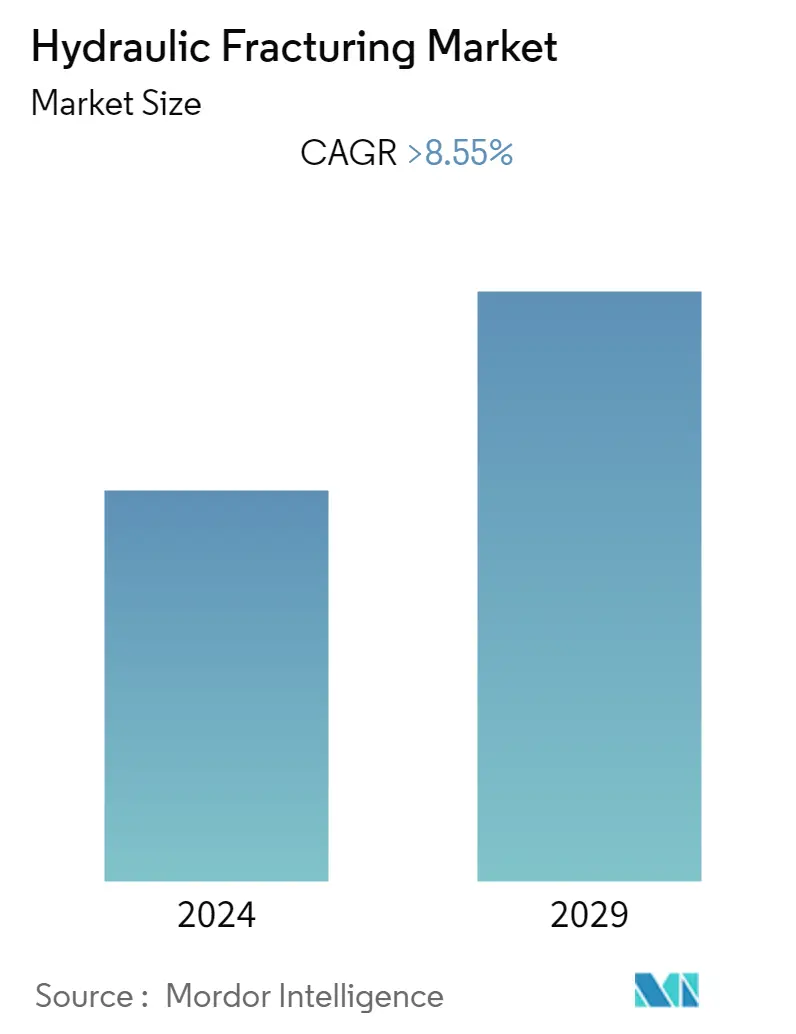
| Study Period | 2020 - 2029 |
| Base Year For Estimation | 2023 |
| CAGR | 8.55 % |
| Fastest Growing Market | Asia Pacific |
| Largest Market | North America |
| Market Concentration | Low |
Major Players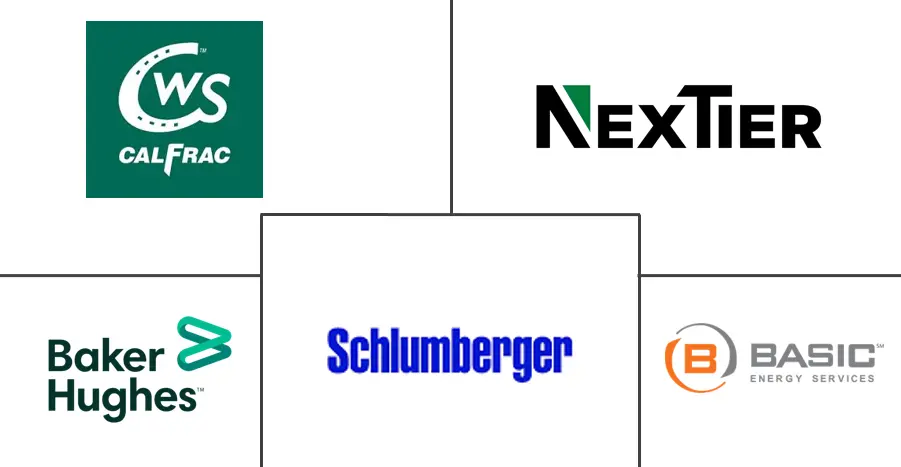
*Disclaimer: Major Players sorted in no particular order |
Hydraulic Fracturing Market Analysis
The hydraulic fracturing market is expected to register a CAGR of greater than 8.55% during the forecast period of 2022 - 2027. The outbreak of the COVID-19 pandemic in Q1 of 2020 severely affected the hydraulic fracturing market. During the COVID-19 pandemic, the shale oil and gas sector suffered the most, which are among the largest sector where the different techniques of hydraulic fracturing are used. Also, the oil and gas demand slumped by more than 30 MMbbl/d in April 2020, which, in turn, affected the market. Factors, such as technological advancements with the introduction of better techniques, are likely to drive the hydraulic fracturing market during the forecast period. However, the volatility in crude oil prices is expected to restrain the growth of the hydraulic fracturing market in the coming years.
- The foam-based segment is expected to witness significant growth due to its increasing usage and rising exploration and development in global oil and gas operations.
- The advancement in hydraulic fracturing techniques and the increasing viability of vertical integration are expected to act as an opportunity for the market.
- With a significant number of oil and gas upstream projects that require hydraulic fracturing, North America is expected to dominate the market during the forecast period.
Hydraulic Fracturing Market Trends
This section covers the major market trends shaping the Hydraulic Fracturing Market according to our research experts:
The Foam-based Fluid Segment to Witness a Significant Growth
- For water-sensitive formations and environments where water is scarce, foams have long been considered one of the best fracturing fluids. In particular, foams are believed to be an appropriate means for fracturing shale gas reservoirs.
- Foam-based fluids require lower (or no) water consumption and cause less damage in water-sensitive formations, and there is less liquid to recover and handle after the fracturing process. Many environmentalists, especially in the United States, have argued for cleaner methods of fracturing, which is possible through the use of foam-based fracturing. Further advancement in this technology may aid the growth of the market while also preventing environmental damage.
- Additionally, foam-based fluid has also found niche application in coalbed fracturing in Canada on dry coalbeds, where any water introduced into the formation damages the cleats.
- Although this technique has been tested in a few shale plays worldwide, most studies have been performed in the United States and Canada. Therefore, the foam fracturing technique is still comparatively novel for other countries around the world.
- The most common application for high-quality foams is in water-sensitive gas-bearing formations, typically an under-saturated gas reservoir, where water blockage is a major concern. Foams are beneficial when used for liquids-rich gas wells, such as in the Alberta Deep Basin in Canada, and work in certain oil-bearing formations, such as the Cardium. Lastly, in areas where water is in short supply or hard to source, foams can present a very obvious advantage.
- The crude oil production in Alberta reached 1,280 cubic meters per day. Also, according to the Alberta Energy Regulator, total crude oil production in Alberta is forecast to be around 4.2 million barrels per day in 2025.
- Therefore, the increasing demand for foam-based fluids in different regions is expected to drive the market during the forecast period.
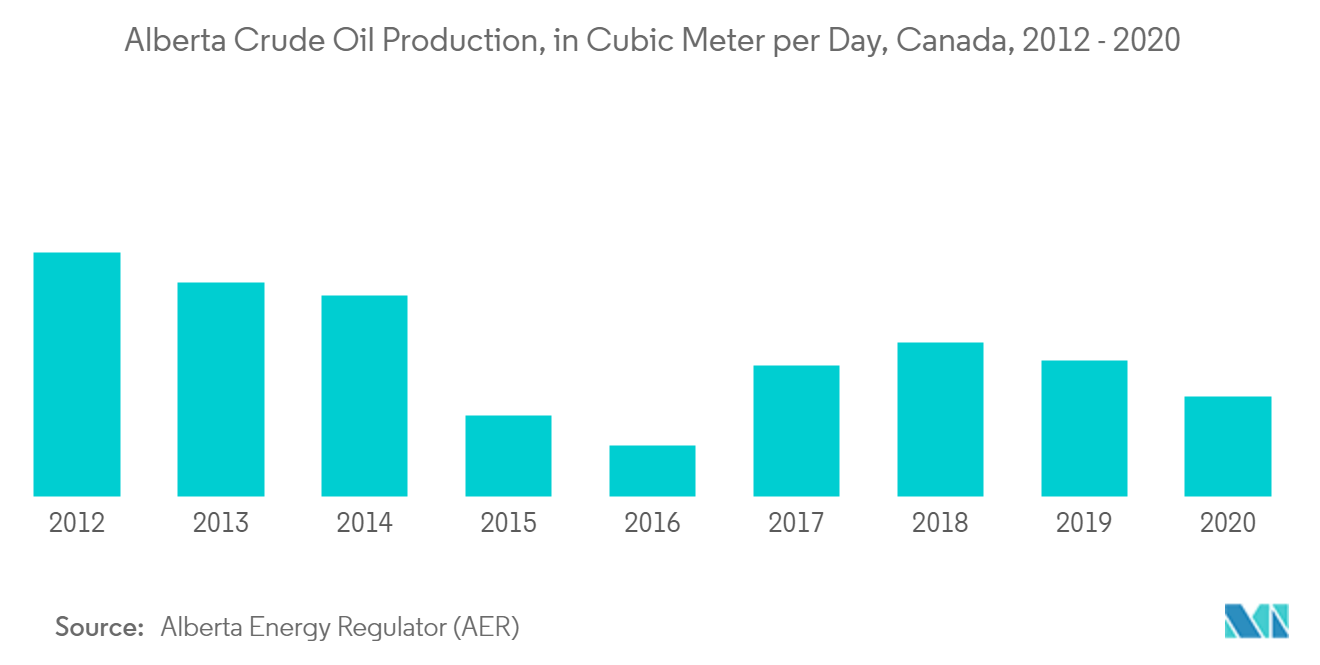
North America to Dominate the Market
- North America is one of the major producers of crude oil and natural gas globally. The hydraulic fracturing market is expected to be driven forward by new well drilling and the expanding producing well base.
- In the United States, the hydraulic fracturing market is primarily driven by increased drilling activities, new offshore projects, and the redevelopment of matured fields. The production from Marcellus/Utica shale and new oil wells is expected to account for most of the growth in gas production.
- The biggest increase in activity is expected from Canada's main crude oil and gas producing region, Alberta, in the coming years. Consequently, the hydraulic fracturing market is estimated to grow at a moderate pace in Canada.
- In January 2021, Reliance Industries Ltd agreed to sell its entire stake in certain upstream assets in the Marcellus shale gas asset in south-western Pennsylvania in the United States for USD 250 million amid weakness in the global hydrocarbon market. The assets, controlled by RIL's wholly-owned unit Reliance Marcellus LLC and operated by affiliates of EQT Corporation, a United States-based energy company engaged in hydrocarbon exploration and pipeline transport, are to be sold to Northern Oil and Gas (NOG) Inc. The shock caused by COVID-19 has caused many smaller investors in the shale region to delay or abandon the projects in the industry.
- According to the US Energy Information Administration (EIA), shale oil production in the United States output would increase by 27% in 2050. The shale oil production may increase further due to new wells being drilled across the country.
- Hence, North America is expected to dominate the market due to the overwhelming production of shale on the continent and the increase in investment in the sector.
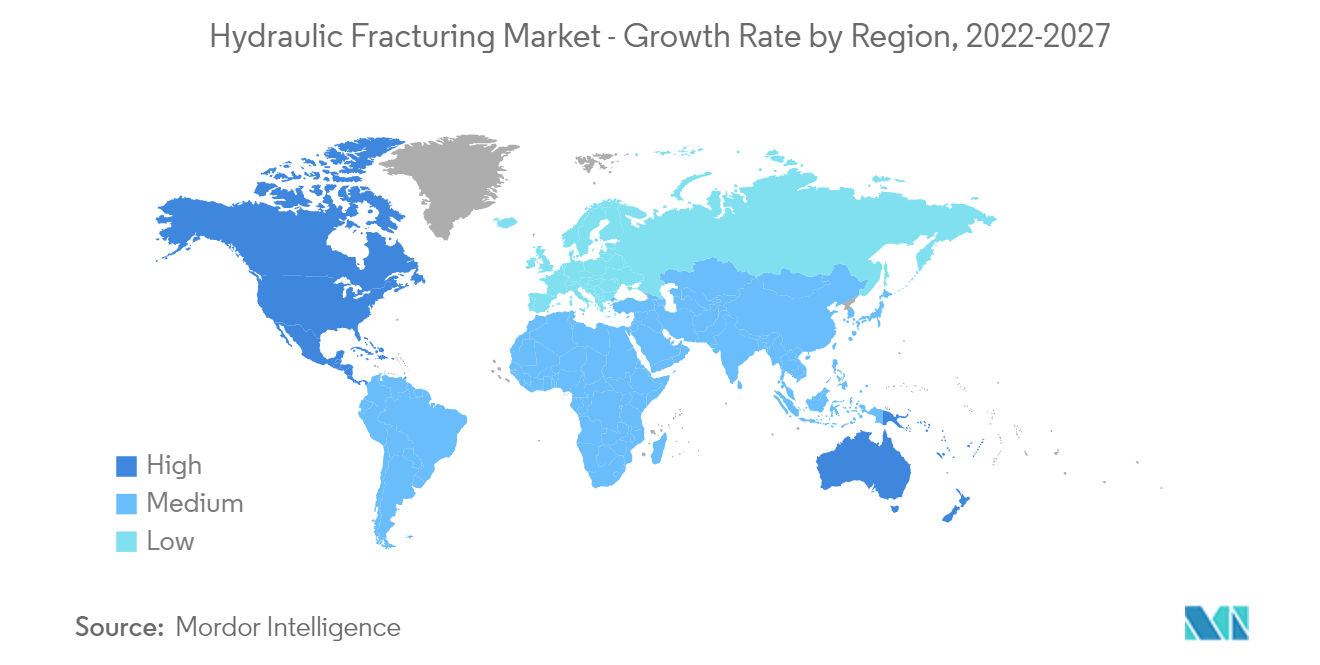
Hydraulic Fracturing Industry Overview
The hydraulic fracturing market is moderately fragmented. Some of the major companies include Schlumberger Limited, Baker Hughes Co., Basic Energy Services, NexTier Oilfield Solutions Inc., and Calfrac Well Services Ltd.
Hydraulic Fracturing Market Leaders
-
Schlumberger Limited
-
Basic Energy Services
-
Calfrac Well Services Ltd
-
Baker Hughes Co.
-
NexTier Oilfield Solutions Inc.
*Disclaimer: Major Players sorted in no particular order
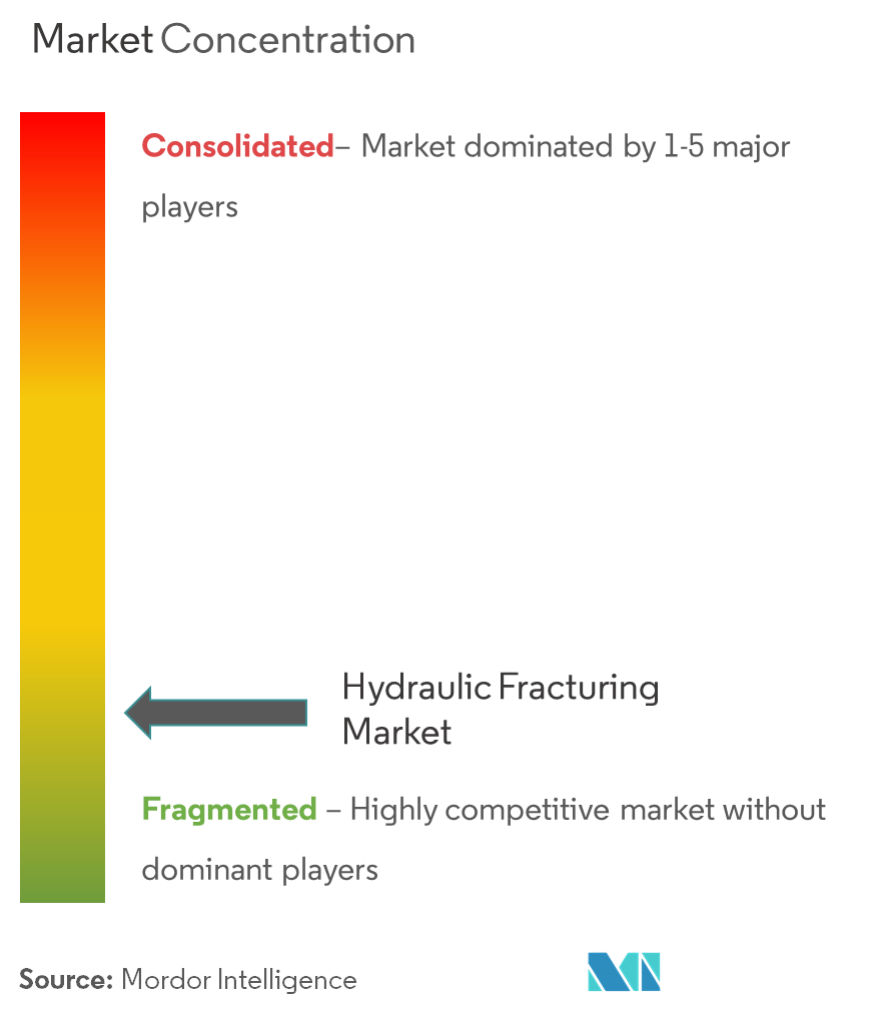
Hydraulic Fracturing Market News
- In January 2022, a researcher at Texas A&M University came up with a novel 3D printing-based approach to accurately simulate the hydraulic fracturing or fracking oil and natural gas mining process.
- In North America, North Dakota voted to repurpose USD 221 million in federal coronavirus aid to various state agencies, including a USD 16-million grant to oil companies in support of the fracking process.
- In January 2021, the US Environmental Protection Agency (EPA) told the Texas Commission on Environmental Quality week that the state could take charge of the federal government's responsibilities to regulate discharging produced water if the water met certain toxicity standards. This is expected to push for cleaner hydraulic fracturing methods.
Hydraulic Fracturing Market Report - Table of Contents
1. INTRODUCTION
- 1.1 Scope of the Study
- 1.2 Market Definition
- 1.3 Study Assumptions
2. EXECUTIVE SUMMARY
3. RESEARCH METHODOLOGY
4. MARKET OVERVIEW
- 4.1 Introduction
- 4.2 Market Size and Demand Forecast in USD billion, till 2027
- 4.3 Recent Trends and Developments
- 4.4 Government Policies and Regulations
-
4.5 Market Dynamics
- 4.5.1 Drivers
- 4.5.2 Restraints
-
4.6 Supply Chain Analysis
- 4.6.1 Bargaining Power of Suppliers
- 4.6.2 Bargaining Power of Consumers
- 4.6.3 Threat of New Entrants
- 4.6.4 Threat of Substitutes Products and Services
- 4.6.5 Intensity of Competitive Rivalry
5. MARKET SEGMENTATION
-
5.1 Well Type
- 5.1.1 Horizontal
- 5.1.2 Vertical
-
5.2 Fluid Type
- 5.2.1 Slick Water-based Fluid
- 5.2.2 Foam-based Fluid
- 5.2.3 Gelled Oil-based Fluid
- 5.2.4 Other Base Fluids
-
5.3 Geography
- 5.3.1 North America
- 5.3.2 Asia-Pacific
- 5.3.3 Europe
- 5.3.4 South America
- 5.3.5 Middle-East and Africa
6. COMPETITIVE LANDSCAPE
- 6.1 Mergers and Acquisitions, Joint Ventures, Collaborations, and Agreements
- 6.2 Strategies Adopted by Leading Players
-
6.3 Company Profiles
- 6.3.1 Archer Well Company Inc.
- 6.3.2 Baker Hughes a GE Co.
- 6.3.3 Basic Energy Services
- 6.3.4 Calfrac Well Services Ltd
- 6.3.5 FTS International Services
- 6.3.6 Halliburton Company
- 6.3.7 NexTier Oilfield Solutions Inc.
- 6.3.8 Patterson (Seventy Seven)
- 6.3.9 RPC Inc. (Cudd Pumping)
- 6.3.10 Schlumberger Limited
- 6.3.11 Liberty Oilfield Services
- *List Not Exhaustive
7. MARKET OPPORTUNITIES AND FUTURE TRENDS
** Subject To AvailablityHydraulic Fracturing Industry Segmentation
The hydraulic fracturing market report includes:
| Well Type | Horizontal |
| Vertical | |
| Fluid Type | Slick Water-based Fluid |
| Foam-based Fluid | |
| Gelled Oil-based Fluid | |
| Other Base Fluids | |
| Geography | North America |
| Asia-Pacific | |
| Europe | |
| South America | |
| Middle-East and Africa |
Hydraulic Fracturing Market Research FAQs
What is the current Hydraulic Fracturing Market size?
The Hydraulic Fracturing Market is projected to register a CAGR of greater than 8.55% during the forecast period (2024-2029)
Who are the key players in Hydraulic Fracturing Market?
Schlumberger Limited, Basic Energy Services, Calfrac Well Services Ltd, Baker Hughes Co. and NexTier Oilfield Solutions Inc. are the major companies operating in the Hydraulic Fracturing Market.
Which is the fastest growing region in Hydraulic Fracturing Market?
Asia Pacific is estimated to grow at the highest CAGR over the forecast period (2024-2029).
Which region has the biggest share in Hydraulic Fracturing Market?
In 2024, the North America accounts for the largest market share in Hydraulic Fracturing Market.
What years does this Hydraulic Fracturing Market cover?
The report covers the Hydraulic Fracturing Market historical market size for years: 2020, 2021, 2022 and 2023. The report also forecasts the Hydraulic Fracturing Market size for years: 2024, 2025, 2026, 2027, 2028 and 2029.
Hydraulic Fracturing Industry Report
Statistics for the 2024 Hydraulic Fracturing market share, size and revenue growth rate, created by Mordor Intelligence™ Industry Reports. Hydraulic Fracturing analysis includes a market forecast outlook to 2029 and historical overview. Get a sample of this industry analysis as a free report PDF download.



